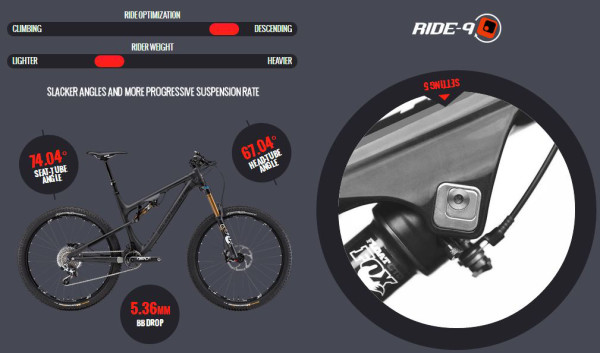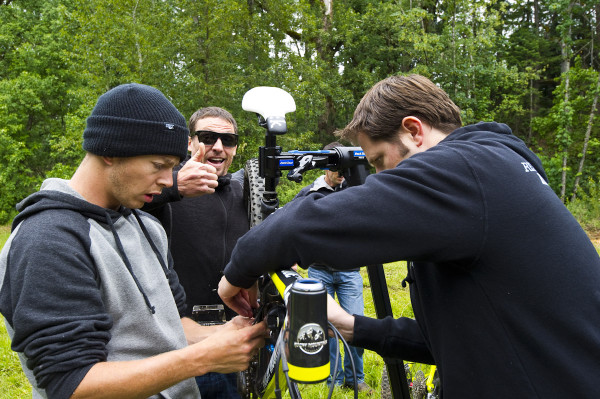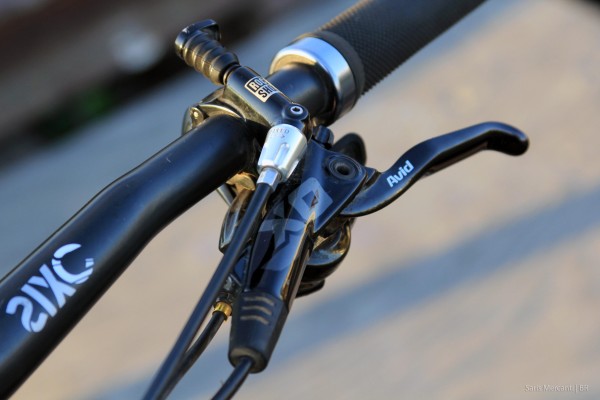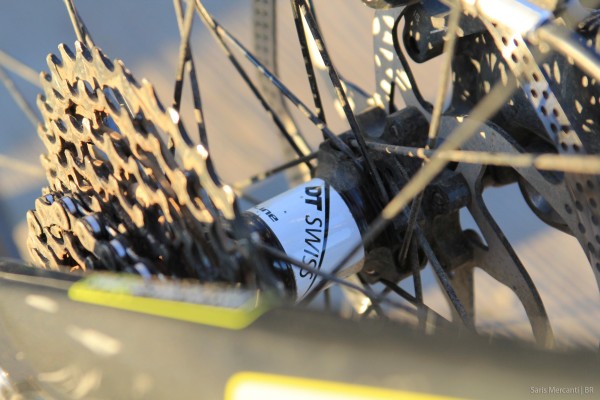The Altitude 790 MSL is Rocky Mountain’s first foray into the tweener wheel size and the culmination of a lot of new technology. Designed around the Ride 9 system, which is also available on the Instinct 29ers, it’s a 150mm travel trail bike with several distinct personalities.
Over the course of the summer and into the early fall, we had the opportunity to put down a few hundreds miles on the new wonderbike. Hop past the break to see how it fared…
Weigh In
Before the fight, every contender needs to step on the scale. Our test bike hit the rink at just over 27 lbs with tubes and a Maxxis High Roller 2 tire installed. The aggressive Maxxis tire weighed nearly a quarter pound more than the stock Nobby Nic it replaced.
We also added a few other things not pictured over the course of the review that pushed the weight of this bike into the high 27 lb range, including a 2014 Fox Talas and Float X shock. These components closely mirrored the build kit of the enduro race ready “Rally edition” Altitude that Rocky Mountain released later in the season. You can read Tyler’s one-ride review of that model here.
The Numbers

The Altitude is available in either carbon or aluminum trim. Our review model came with all the fixing and retails for a healthy $6,899, but you can find a complete at your LBS for as little as $2,849.
The marketing puts this frame squarely in the trail category, but the unique Ride 9 adjustable geometry allows their rider to tune their bike for anything from XC to Enduro usage. The is done via two interlocking chips, which can be rotated to adjust the headtube and seatube angle, BB drop, and progressiveness of the shock. Over out testing period, we spent the majority of the time in the stock setting, but also played with making the bike slacker and more progressive.
Fit
The Rocky Mountain Altitude is available in five different sizes, XS-XL. We tested a medium frame with a 23“ (585mm) TT and 28.9“ (734mm) stand over. It’s interesting to note that all five different frames share the same stand over height. According to Anja Koehler, the Marketing Coordinator, this is because the suspension pivots are in same position across all the frame sizes. Essentially, they made the bike as low as possible in the XS size and carried that same stand over height all the way up to the XL.
In terms of fit, the medium frame felt roomier than the numbers suggested and could comfortably fit someone taller than my 5‘8“ with a longer stem. We swapped between a 70mm, 60mm, 50mm, and a 35mm stem over the course of our testing, but I found the 50mm worked really for my build.
That said, the standover was a touch high for me when standing flat footed on the ground, which is something to consider for those interested in the size small or extra small frames. I also found that because the bike was equipped with a 5“ dropper, even when the post was slammed to it’s maximum insertion point, the saddle was just slightly too high for me. Which meant I always had to push the Reverb post down slightly to achieve the perfect pedaling height.
Component Check
For this bike’s intended purposes, the overall spec of the top of the line 790 MSL model is exactly what you’d expect. The 2×10 XO drivetrain shifted smoothly and the gearing worked well with the tweener wheels.
The only issue we encountered, which we mentioned in our first impressions article, was a clicking noise from the clutch equipped derailleur. One quick call to SRAMs customer service, which is one of the best in the industry, and they shipped out a replacement to our local bike shop at no cost. No “hey, I write for Bikerumor” name dropping required.
Over the course of the summer we went through a set of brake pads (front and rear) and performed two bleeds on the XO brakes. While the online spec says the bike comes stock with the 4 pot SRAM XO Trail brakes, our ride came equipped with regular XO brakes. These offered good modulation but not enough power, and they had a frequent habit of turning mushy on hairy descents. The more powerful XO Trail brakes are definitely the right spec for the bike’s 150mm of travel.
Ever since wide bars became the norm, 720mm wide have been relegated to the XC realm. Yet for some reason, the 720mm RaceFace SixC bars just felt right. Since this bike was released, RaceFace has since updated the SixC bars by making them wider, stiffer, and lighter. We hope to see this bar spec’d again next year, because the extra millimeters will give riders the ability to cut their bars down to their preferred width without alienating those who want something wider.
Before packing the Rocky Mountain into a bike box and shipping it back to Canada, we put each wheel on the truing stand. We didn’t touch them all summer and yet neither wheel needed more than a few turns of the wrench. That’s probably not that impressive in retrospect, since we never case jumps, or huck to flat, or have fun on our mountain bikes. Never. Not once.
The only issue we encountered with the wheels was when we swapped out the tires. The tubeless tape had shifted weirdly, with part if of it working its way up past the rim bead, which made it impossible to setup new tires tubeless without replacing the rim strip.
As we mentioned in our first impressions article, the Nobby Nic tires that came on the bike stock were not long for this world. The light weight and fast rolling tires wore quickly and drifted fast and furiously. Swapping to 2.4“ Maxxis High Roller IIs front and rear completely changed the character of the Rocky, curing it of the drifting curse. But they added an extra half pound of heft.
Mechanic’s Corner

This picture exemplifies our experience wrenching on the Altitude. It’s one of those bikes that requires a minimum of three mechanics. One to hold the flashlight, another to work on the bike, and a third to buy beer.
For example, a simple snapped rear derailleur cable on the trail became an hour long calamity because we didn’t have a bright flashlight handy. Since the Reverb and front/rear derailleur cables are internally routed through the downtube, you must loosen both cables and pull down on the Reverb housing to access the cable port. Once you’ve gotten this far, fishing the cable through the downtube becomes a real hassle because it lacks an internal guide. If you have a bright light, dental pick, and a good deal of patience, it’s not a big deal. But it’s a PIA on the trail.
Long term, some riders who have been burned by bushings in the past might be concerned to hear that Rocky has used them throughout on the Altitude. They company has used them extensively in several other recent models and claims that their (ABC Concept) bushings, which have an angular polymer surface, help to increase stiffness and saves nearly a quarter pound when compared to traditional bearings. We didn’t spend much time riding in the mud during our review period, but we did have to clean and re-torque the pivots twice in order to track down a persistent creaking that occurred during hard out of the saddle efforts.
On The Trail

Bone stock out of the box, the Altitude was a great companion for long days in the saddle. Its lively demeanor on descents made it a joy to manual over obstacles and pop off the bonus hits, but like many other media outlets and riders, we found the stock tune on the 2013 Fox suspension to be too linear. As a result, the suspension had a bad tendency to dive under hard breaking or when squaring up a berm.
So when Fox called and asked if we wanted to fly out and test their new 2014 Talas Fork and Float X shock at one of the Oregon Enduro Races, we eagerly packed up the Rocky Mountain and a bottle of Tequila. The new Kashima coated components helped transform the Altitude into the ultimate trail weapon.
With the Talas fork installed, we spent the majority of our time chasing miles of singletrack in the lower position, which helped quicken the steering, and made an already playful bike even more fun darting between trees on undulating singletrack.
The Float X shock also brought some welcome changes in performance for the rear suspension. In it’s stock configuration, the Altitude has a linear tune and a tendency to bottom out on harsh hits, which can be curtailed somewhat by adjusting the leverage curve using the Ride 9 system. Making a switch from the stock shock to the more aggressive Float X greatly reduced the instances of hard bottom outs on drops of more than 3 or 4 feet.
Another advantage to running the Float X was the stiffer damping offered in the climb mode over the 2013 CTD shock. Regardless of shock though, the Altitude does exhibits some pedal bob in the small ring, and was not overly efficient during out of the saddle exertions. This is likely the reason that Rocky equipped a remote lever on the handlebar to actuate the shock. I normally hate on excess levers, but the ability to adjust the shock’s compression on the fly could easily help a racer shave a few precious seconds over the duration of a timed descent.
We also discerned a small degree of flex from the rear when turning, which allowed the bike to oversteer slightly, and really hammer through corners. While that kind of flex was great for corner induced grins, it did cause the bike to feel less stable through rock gardens than others we’ve since tested in the same category.
Bottom line is the Rocky Mountain was an incredibly fun bicycle to ride. In every configuration we tried, the Altitude was still eager to rail berms and get airborne. We can envision the ability to fine tune the bikes handling with the Ride 9 system to be a boon for racers and tinkerers, although we were happiest leaving the bike in a close to stock setting, with a slightly more progressive suspension rate. This setting offered a great balance between climbing and descending prowess, and seemed to best suit the character of the bike. Even with our test rig equipped with most of the fancy bits found on the Rally Edition, the Altitude was never a downhill bruiser with trail legs. Rather, it excelled on all day adventures and quick after work sprints, where it’s excellent seated climbing ability and all around flick-ability made it one hell of a trail bike.





